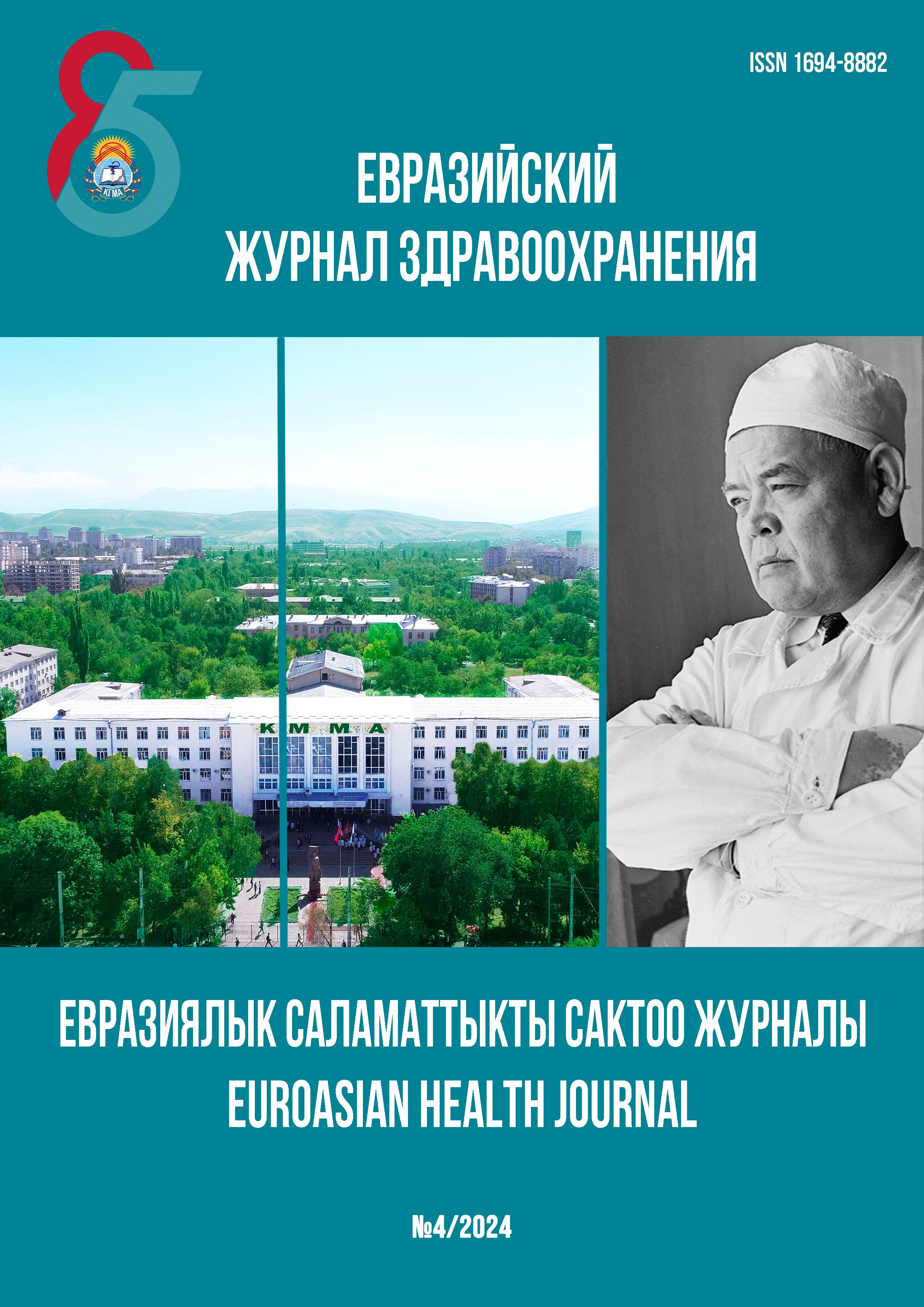PRMARI ENDOPROSTHETICS FOR DYSPLASTIC COXARTHROSES
DOI:
https://doi.org/10.54890/1694-8882-2024-4-133Abstract
In the period from 2006 to 2021, 377 patients with dysplastic coxarthrosis aged 16 to 68 years who underwent total hip replacement using endoprostheses from foreign companies were under our supervision at the Bishkek Research Center of Traumatology and Orthopedics. The follow- up period ranged from 6 months to 15 years. All patients with dysplastic coxarthrosis, in accordance with the J.F. Crowe classification, are divided into three subgroups that determine the degree of dysplasia depending on the subluxation (magnitude of proximal migration) of the femoral head. The first subgroup included 176 patients who underwent 230 total hip replacement operations on the background of grade I dysplasia, the second – 132 patients with grade II and III dysplasia who underwent endoprosthesis of 152 joints, and the third subgroup ‒ 69 patients who underwent 70 hip replacement on the background of grade IV dysplasia (with high dislocation hips).
In order to solve the problem of hip replacement with defects in the coverage of the acetabular component with bone tissue, we have developed and put into practice a method of mathematical calculation in which a mathematical model is created with the help of which the optimal size of the working surface of the acetabulum for the acetabular component of the endoprosthesis is calculated as a percentage.
Statistical analysis of the data obtained and assessment of the outcomes of treatment of patients with dysplastic coxarthrosis using the method of total endoprosthetics revealed positive dynamics in 84.6% of observations.
Keywords:
dysplastic arthrosis, total endoprotesis, implant, bone cementReferences
1. Teplenkiy MP, Kaminsky AV, Fozilov DT. The effect of previous surgical treatment on the outcome of total hip replacement in young patients with dysplastic coxarthrosis. Genij Ortopedii. 2023;29(5):481-486. https://doi.org/10.18019/ 1028-4427-2023-29-5-481-486
2. Eremin IK, Daniliyants AA, Zagorodniy NV. Comparative evaluation of the clinical efffcacy and safety of surgical approaches in total hip arthroplasty. Genij Ortopedii. 2023;29(4):438-448. https://doi.org/10.18019/1028-4427-2023-29-4-438-448
3. Калчаев Б.Н. Способ эндопротезирования тазобедренного сустава при высоком врожденном вывихе бедра. Медицина Кыргызстана. 2012;1:34-36.
4. Basit S, Alharby E, Albalawi AM, Khoshhal KI. Whole genome SNP genotyping in a family segregating developmental dysplasia of the hip detected runs of homozygosity on chromosomes 15q13.3 and 19p13.2. Congenit Anom (Kyoto). 2018;58(2):56-61. https://doi.org/10.1111/cga.12235
5. Harsanyi S, Zamborsky R, Krajciova L, Kokavec M, Danisovic L. Genetic Study of IL6, GDF5 and PAPPA2 in Association with Developmental Dysplasia of the Hip. Genes (Basel). 2021;12(7):986. Published 2021 Jun 28. https://doi.org/10.3390/ genes12070986
6. Джамалбекова Э.Ж., Байгараев Э.А. Комплексная диагностика и сравнительное лечение дисплазии тазобедренных суставов у детей. Вестник КГМА им. И.К. Ахунбаева. 2018;2:54-57.
7. Tachdjian M.O., ed. Tachdjians pediatric orthopaedics: from the Texas Scottish Rite Hospital for Children. Elsevier Health Sciences; 2014.
8. Денисов А.О., ред. Диспластический коксартроз на фоне врожденного вывиха бедра и другие диспластические коксартрозы: клинические рекомендации. С-Петербург: ФГБУ «РНИИТО им. Р.Р. Вредена; 2013. 28 с.
9. Feldman GJ, Parvizi J, Sawan H, Erickson JA, Peters CL. Linkage mapping and whole exome sequencing identify a shared variant in CX3CR1 in a large multi-generation family. J Arthroplasty. 2014;29(9):238–241. https://doi.org/ 1010.1016/j.arth.2014.05.014
10. Zhang J, Yan M, Zhang Y, Yang H, Sun Y. Association analysis on polymorphisms in WISP3 gene and developmental dysplasia of the hip in 39 Han Chinese population: A case-control study. Gene. 2018;20;664:192–195. https://doi.org/ 1010.1016/j.gene.2018.04.020







